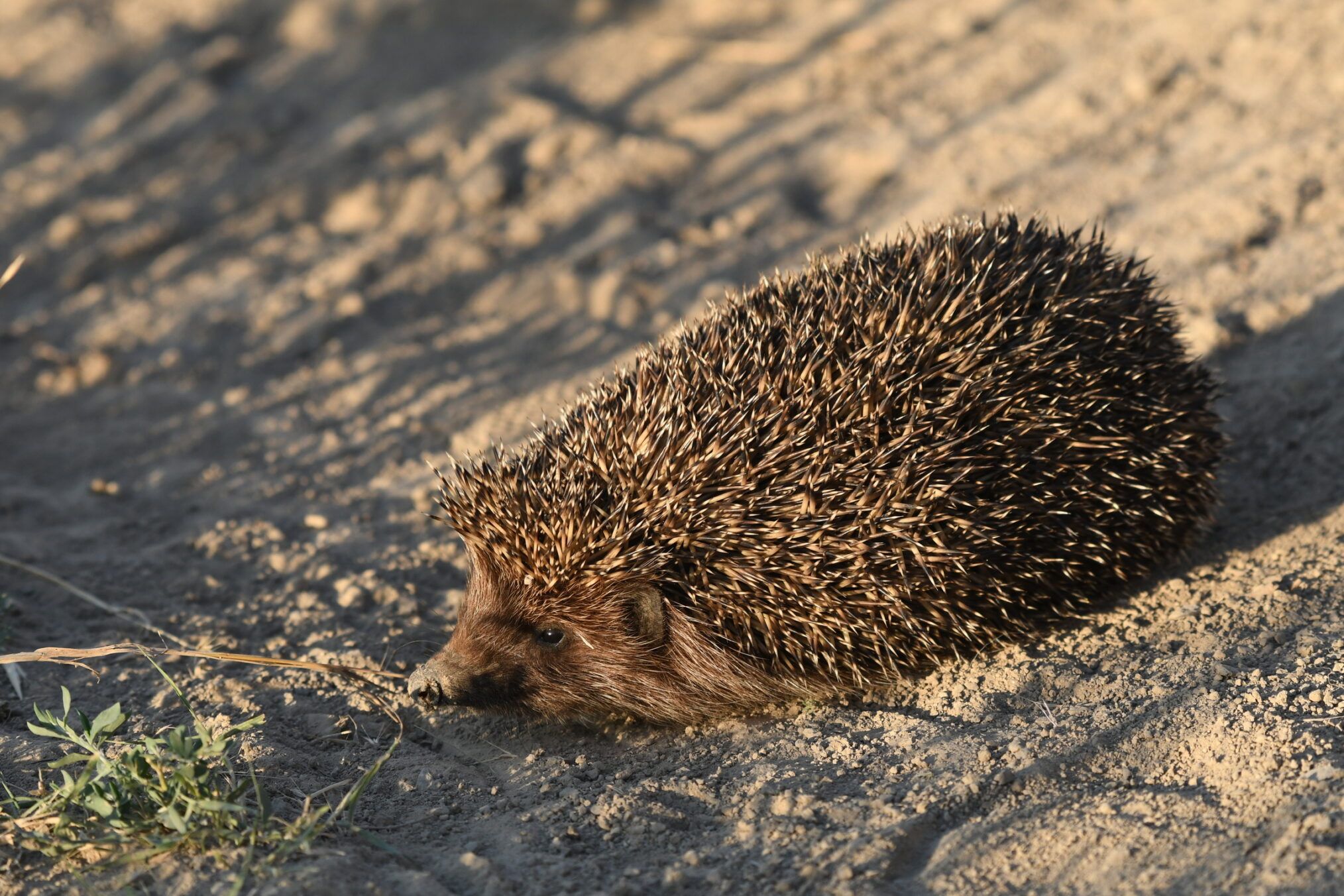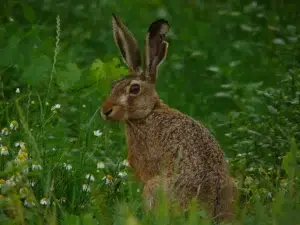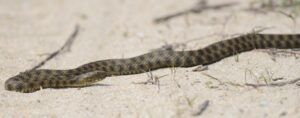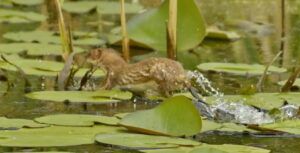The European hedgehog (Erinaceus europaeus), also known as the West European hedgehog or common hedgehog, is a hedgehog species native to Europe from Iberia and Italy northwards into Scandinavia and westwards into the British Isles. It is a generally common and widely distributed species that can survive across a wide range of habitat types. It is a well-known species, and a favourite in European gardens, both for its endearing appearance and its preference for eating a range of garden pests. While populations are currently stable across much of its range, it is declining severely in Great Britain where it is now Red Listed, meaning that it is considered to be at risk of local extinction. Outside its native range, the species was introduced to New Zealand during the late-19th and early-20th centuries.
Description
The European hedgehog has a generalised body structure with unspecialised limb girdles. It appears brownish with most of its body covered by up to 6,000 brown and white spines. The length of head and body is ~160 mm (6.3 in) at weaning, increasing to 260 mm (10 in) or more in large adults. It has an extremely short tail as an almost vestigial feature, typically 20 to 30 mm (0.79 to 1.18 in).Weight increases from around 120 g (4.2 oz) at weaning to > 1,100 g (2.4 lb) in adulthood. The maximum recorded weight is 2,000 g (4.4 lb), though few wild specimens exceed 1,600 g (56 oz) even in autumn. Adult summer weight is typically somewhat less than in autumn, with an average of around 800 g (28 oz) and adult weights commonly as low as 500 g (18 oz). Males tend to be slightly larger than females, but sex differences in body weight are overshadowed by enormous seasonal variation.
The European hedgehog is unlike any other creature across most of its range. Where it co-exists with the northern white-breasted hedgehog (Erinaceus roumanicus), the two species are difficult to distinguish in the field, the latter having a white spot on its chest. It is probably the largest hedgehog species and is possibly the heaviest member of the order Erinaceomorpha.
Leucistic or ‘blonde’ hedgehogs occasionally occur. Such specimens are believed to have a pair of rare recessive genes, giving rise to their black eyes and creamy-colored spines; however, they are not strictly speaking albino. They are extremely rare, except on North Ronaldsay and the Channel Island of Alderney where around 25% of the population is thought to be blonde. True albino morphs of the hedgehog occur infrequently.
Behaviour and ecology
The European hedgehog is largely nocturnal. It has a hesitant gait, frequently stopping to smell the air. Unlike the smaller, warmer-climate species, the European hedgehog may hibernate in the winter. However, most wake at least once to move their nests.
Diet
The European hedgehog is an insectivore. Its diet consists largely of earthworms, as well as snails and slugs, beetles, ants, bees, and wasps, earwigs, cockroaches, crickets and grasshoppers, butterflies and moths, and caterpillars and other insect larvae. Eggs of ground-nesting birds are also taken, and carcasses may be foraged on. Hedgehogs may also eat lizards, snakes, frogs, and small rodents. Plant matter appears to make up only a negligible part of the hedgehog’s diet.
The breeding season commences after hibernation. Pregnancies peak between May and July, though they have been recorded as late as September. Gestation is 31 to 35 days. The female alone raises the litter which typically numbers between four and six, though can range from two to ten. Studies have indicated that litter size may increase in more northern climes. The young are born blind with a covering of small spines. By the time they are 36 hours old, the second, outer coat of spines begins to sprout. By 11 days they can roll into a ball. Weaning occurs at around six weeks of age.
Longevity and mortality
European hedgehogs may live to ten years of age, although the average life expectancy is three years. Starvation is the most common cause of death, usually occurring during hibernation. If alarmed, the animal will roll into a ball to protect itself. Many potential predators are repelled by its spines, but predation does occur. Remains of hedgehogs have been found in the stomachs of red foxes (Vulpes vulpes), European badgers (Meles meles) and pine martens (Martes martes). A large portion of these may be from hedgehog carcasses, especially roadkill. However, hedgehogs tend to be absent from areas where badgers are numerous.
Eurasian eagle-owls (Bubo bubo) and golden eagles (Aquila chrysaetos) are the only regular avian predators of this species and may even prefer them as prey. The owl, after grabbing the hedgehog by its face, tends to skin the mammal’s prickly back with its talons before consumption, resulting in several hedgehog backs being found around eagle-owl roosts and nests. In Spain, reduction of European rabbit (Oryctolagus cuniculus) numbers due to rabbit haemorrhagic disease has made the European hedgehog one of the top preferred prey species for eagle-owls. Elsewhere, eagle-owls often prefer these hedgehogs to any other prey species, as the hedgehog can comprise up to 23% by number and 30.7% by biomass of eagle-owl prey remains. On the Swedish island of Gotland the golden eagle may take larger numbers of hedgehogs than any other prey due to an otherwise low diversity of native land mammals, although the introduction of European rabbits has shifted the eagle’s prey preferences there.
Distribution and habitat
The European hedgehog is endemic to Europe (including European Russia), with a global distribution extending from the British Isles and the Iberian Peninsula eastwards through much of western to central Europe, and from southern Fennoscandia and the northern Baltic to north-west Russia. It is present also on Mediterranean islands (Corsica, Sardinia, Elba, Sicily), on most of the French Atlantic islands as well as on British Islands (autochthonous and introduced). It is an invasive exotic species in New Zealand and has probably been introduced to Ireland and many of the smaller islands where it occurs.
Colonists took hedgehogs from England and Scotland to New Zealand on sailing ships from the 1860s to the 1890s mainly as a biological control against agricultural pests or as a pet. Few survived the ca 50–100 days voyage, but those that did had lost all their fleas. Animals found their first homes in the South Island, where their spread was helped by guards dropping them off at country railway stations. Hedgehogs were introduced to the North Island in the 1890s, but some were also transported from South Island between 1906 and 1911 and, from then on, their numbers increased at an exponential rate. By the 1920s they had become so numerous that game-bird hunters blamed them for reduced bag-sizes. Hedgehogs were declared noxious animals and a bounty of one shilling a snout paid by regional authorities for several years. By the 1950s, hedgehogs could be found over the whole country with the exception of the coldest wettest corner of the South Island and alpine areas of permanent snow. Nevertheless, hedgehogs have been seen climbing New Zealand glaciers. Hedgehogs do not reach the same weight in New Zealand as in colder parts of Europe. With its milder winters, New Zealand hedgehogs hibernate for only three months of the year so do not need to put on so much weight in autumn as their ancestors. In northern New Zealand, many hedgehogs do not hibernate at all. One of New Zealand’s pioneer hedgehogs probably had faulty teeth for this feature is found in about 50% of today’s animals. Most New Zealanders welcome hedgehogs in their gardens as they relish slugs and snails. Conservationists are less happy as hedgehogs compete for invertebrate food with native bush birds and prey on some rare insects, lizards and ground-nesting birds. As a result, extensive hedgehog-control programs are under way in some parts of the country, killing thousands of them. To judge by roadkill counts, North Island hedgehogs were at their highest numbers in the 1950s. Since then, roadkill counts have fallen dramatically from about 50/100 km to less than 1/100 km.
The European hedgehog is found across a wide range of habitat types, encompassing both semi-natural vegetation types and those areas that have been heavily modified by man. The range includes woodland, grasslands such as meadows and pasture, arable land, orchards and vineyards as well as within the matrix of habitat types found in human settlements. It prefers lowlands and hills up to 400–600m, but is also locally present on mountains, exceptionally up to an altitude of 1500-2000m (e.g. Alps and Pyrenees).Outside cultivated land it prefers marginal zones of forests, particularly ecotonal grass and scrub vegetation.
Hedgehogs are most abundant within the gardens, parks and amenity land close to or within human settlements. They are generally scarce in areas of coniferous woodland, marshes and moorland, probably because of a lack of suitable sites and materials for the construction of winter nests (or hibernacula), which have specific requirements.
Photo : Mihai Baciu





